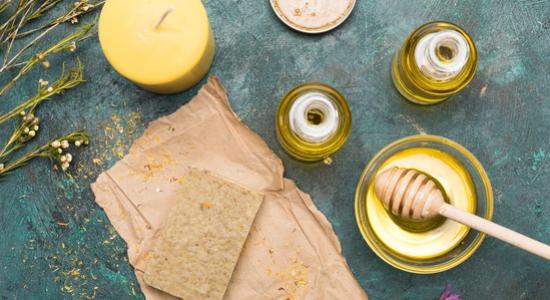See all "Home Remedy" Section Topics
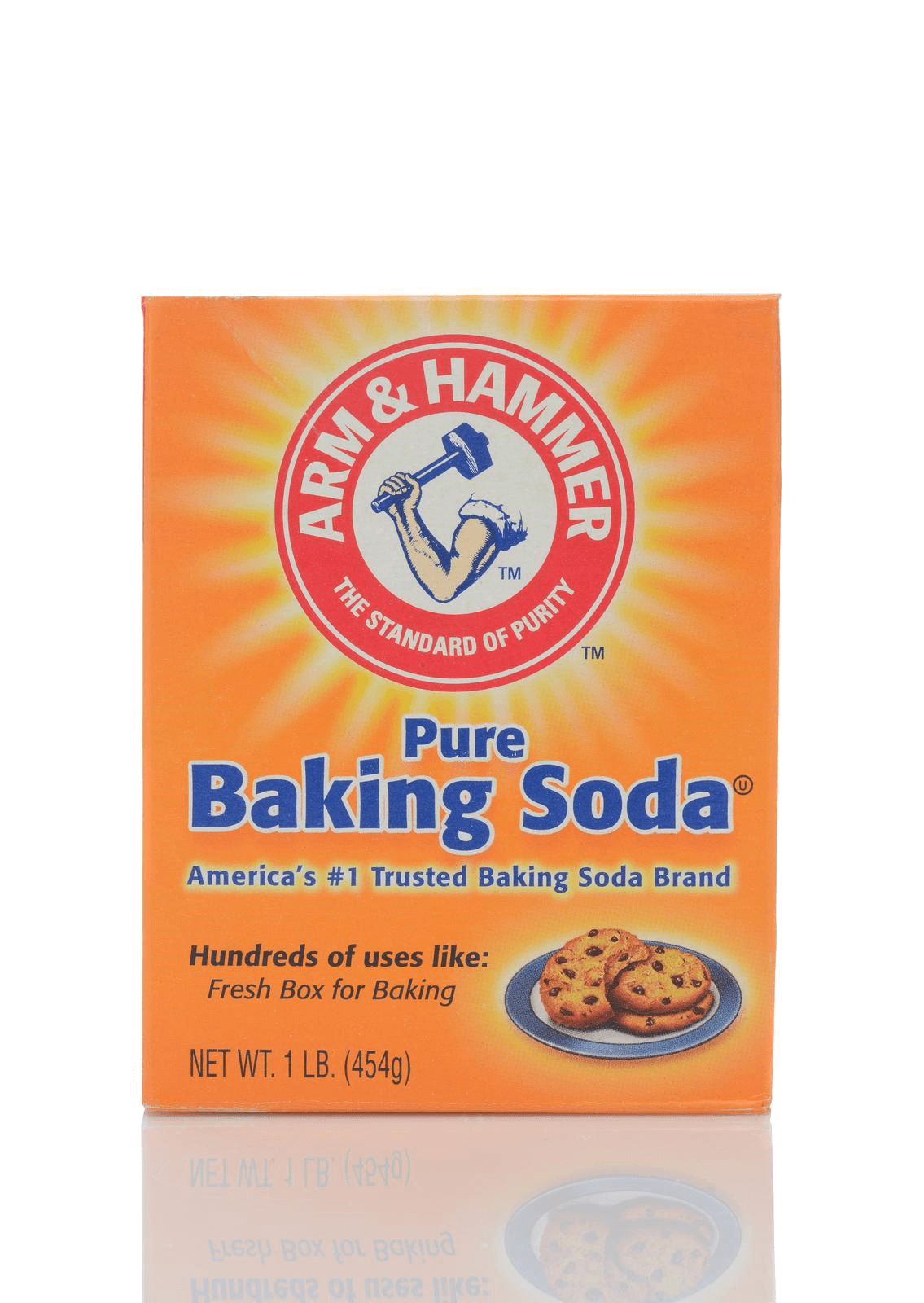
So, is baking soda for yeast infections a viable treatment? The answer is yes, it certainly can be. However, using too much of this common household product can be toxic to the body. Baking soda rapidly alkalizes the body; and, this can cause alkalosis (more on this later). As research indicates, you will need about a 10% concentration of baking soda, in say water, to actually kill Candida cells. About a 5% concentration of this product will stop the growth of the yeast—giving your immune system an easier time when clearing it from your body! You can make a douche with baking soda for vaginal therapy; or, put a paste on the skin that’s affected by this yeast. Either way, there should be some amelioration to your condition after you allow this substance to work on the yeast overgrowth.
According to the literary publication, Essential Guide to Food Additives, baking soda is produced via the industrial manipulation of limestone and brine, via the ammonia soda process. Then, it is further refined by repetitious crystallisation. Baking soda is an easy thing to acquire; as it is frequently found in grocery stores across the globe. This substance is relatively safe to ingest and use on the skin—with the caveat that you don’t over do it. We will talk more on baking soda overdoses; and, yes, you can easily overdose on this household product; if you take too much. Small children can even absorb enough through their skin to get poisoned. So, you may want to take a look, at the rest of this interesting overview on baking soda, before you commence using it. And, always ask a professional medical physician before you use large amounts of baking soda, or using it with small kids!
Personally, I would avoid using baking soda as it may require a long duration of contact with the yeast infected area to show any results. Higher concentrations may quicken the time to kill the yeast; but, they may cause you to absorb too much sodium bicarbonate into your body. Occasional sitz baths, with baking soda throughout the day, should help to relieve vulvar or penile discomfort; such as burning and itching. Baking soda baths may also help to calm the painful burning of the area of skin that is infected. Remember, a large bath (not a sitz bath) will generally be more for comfort than healing. More on these baths for Candida outbreaks later on in this article.
Additionally, ingesting baking soda to try to fight Candida internally is a terrible idea. The concentration of this substance will be very small once it reaches the stomach. The acid in the stomach, of course, will chemically react with the baking soda, rendering it useless for any Candida fighting purposes. In all, do not try and treat a yeast infection by ingesting this product; only use it externally. And, never use it topically on small children.
A 1/2 Day & Yeast is Gone!
Linda Allen suffered from yeast infections for years. Through researching natural medicine & Candida, she found an efficacious solution!
Linda is one expert you want on your side! Let her show you how to get rid of a superficial yeast infection in just 12 hours; AND, keep it gone!
A 60-day, 100% money back guarantee is provided.
Visit Official Site!Research on this Topic
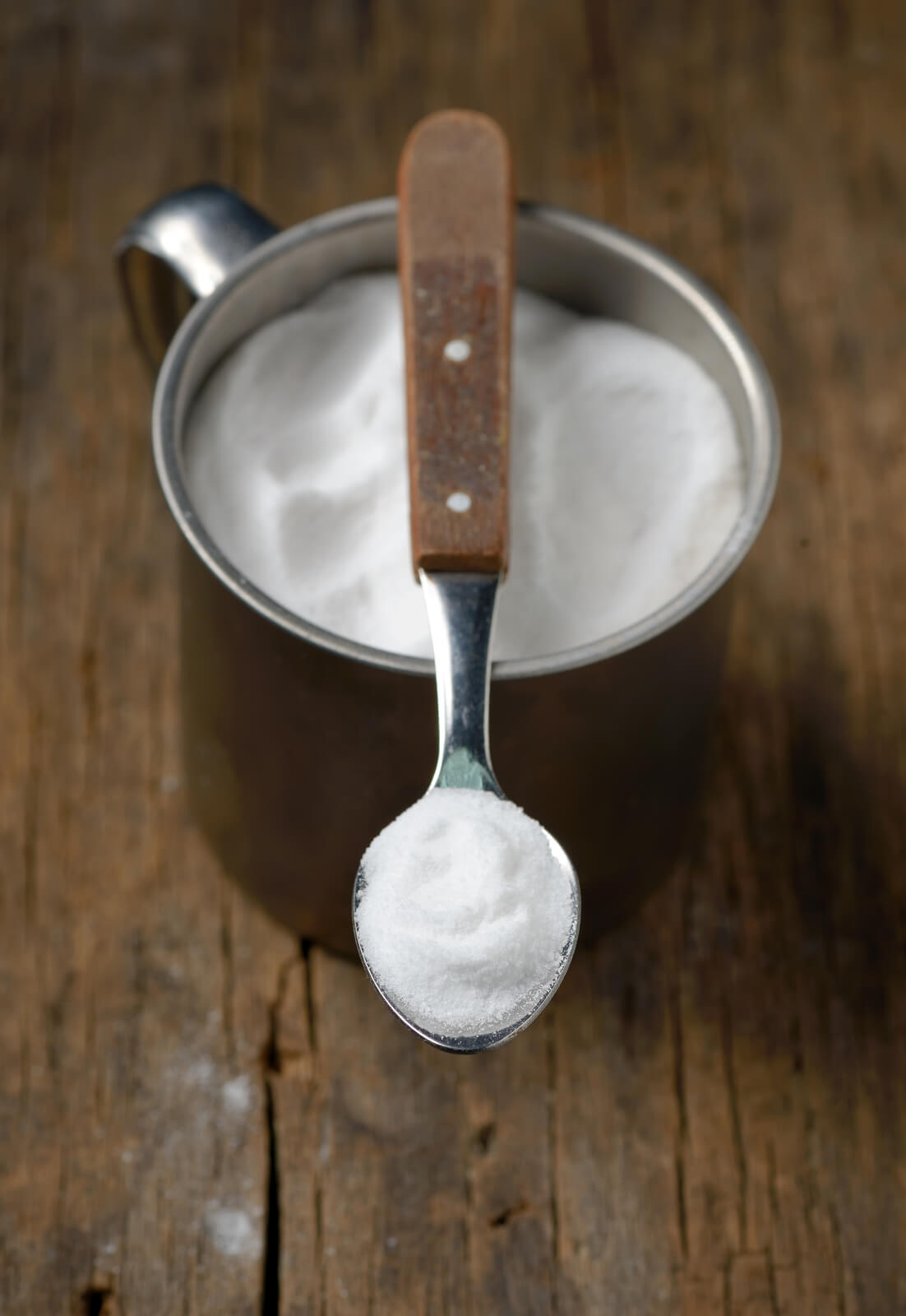
An important study, published in the Saudi Journal of Medicine and Medical Sciences [3.1 (2015): 26], found that baking soda (NaHCO3) can effectively kill Candida albicans. The study found that low concentrations of baking soda did not do much to inhibit the development of this yeast. However, when a concentration of 20 grams of baking soda in 200 mL of solvent, was introduced to the yeast; after 8 hours of contact, all the yeast cells were killed. And, the researchers stated that, after 8 hours of time, this killing power fully manifested.
So, to effectively kill off yeast you may need to use around at least a 10% concentration, and allow it to be in contact with the yeast for at least 8 hours. The study had a focus on use of various household chemicals like baking soda, such as vinegar, for sterilizing dentures. And, the researchers concluded by stating that low concentrations of these chemicals (baking soda included) did not do much to clean dentures—but, higher concentrations of these chemicals, when exposed to the dentures for 8 hours or more, might have a helpful effect.
The next study thoroughly addresses the question: “does baking soda work for fungal infections?” This critical research was published in Mycopathologia [175.1 (2013): 153-158]. The study used 70 different fungal strains isolated from patients with nail fungus (onychomycosis), or skin fungal infections. Of these strains, 18 were yeasts; and, of these, Candida genus strains included 6 Candida albicans strains, 6 Candida parapsilosis strains, 2 Candida guilliermondii strains, and finally one Candida zeylanoides strain. The smallest amount, the study found to stop the growth of the fungi isolates, known as the minimum inhibitory concentration (MIC), for 90% of the fungi; was referred to as MIC90. The study found, that a concentration of baking soda at 10g / L, inhibited 80% of the fungal isolates tested; and, of these, 95% of the yeasts were inhibited at this dilution. At a concentration of 100g / L of baking soda, all of the fungal strains tested were totally inhibited. Of the fungi, baking soda appeared to have the best antifungal effect on the yeasts.
The researchers also checked to see if baking soda had more than an inhibitory activity on yeasts—looking for fungicidal ability (seeing if sodium bicarbonate would do more than just stop growth but actually kill the yeasts). The study used 3 Candida albicans isolates and 1 Candida parapsilosis isolate in their check for the fungicidal ability of baking soda. Unfortunately, the experiment showed that after 72 hours there was a recurrence of growth by the yeasts. Thus, baking soda at low concentrations appears to have only a fungistatic (stopping the growth of fungi) ability; not a killing capability.
The next study we will investigate, also states that baking soda has an inhibitory ability against Candida albicans, Candida lusitaniae, and Candida guilliermondii. The study was published in Current Microbiology [69.3 (2014): 303-310]. The research found that sodium bicarbonate had a weak, delayed ability to inhibit the growth of these yeasts. All of these Candida species’ strains were inhibited by just a 5% concentration of sodium bicarbonate. The researchers also used acetic acid (the acid found in vinegar—more on vinegar therapy here); and, acetic acid was much better than baking soda at stopping yeast growth. Just a fraction of a percent of acetic acid stopped the growth of the Candida. And, acetic acid seemed to work much faster than baking soda at getting rid of the yeast cells.
The following chart, was taken from the study, and shows the affects four different chemicals had on stopping colony forming unit production of three species of Candida. Apoptosis (cell death) was incurred for 40% of all the three Candida species a MIC of baking soda was applied to. You can see the chart below indicates about 60% of the colony forming units (CFUs) remained after the baking soda treatment. The lightest grey bars on the left indicate baking soda. This is a poor performance; however, compared to that of acetic acid.
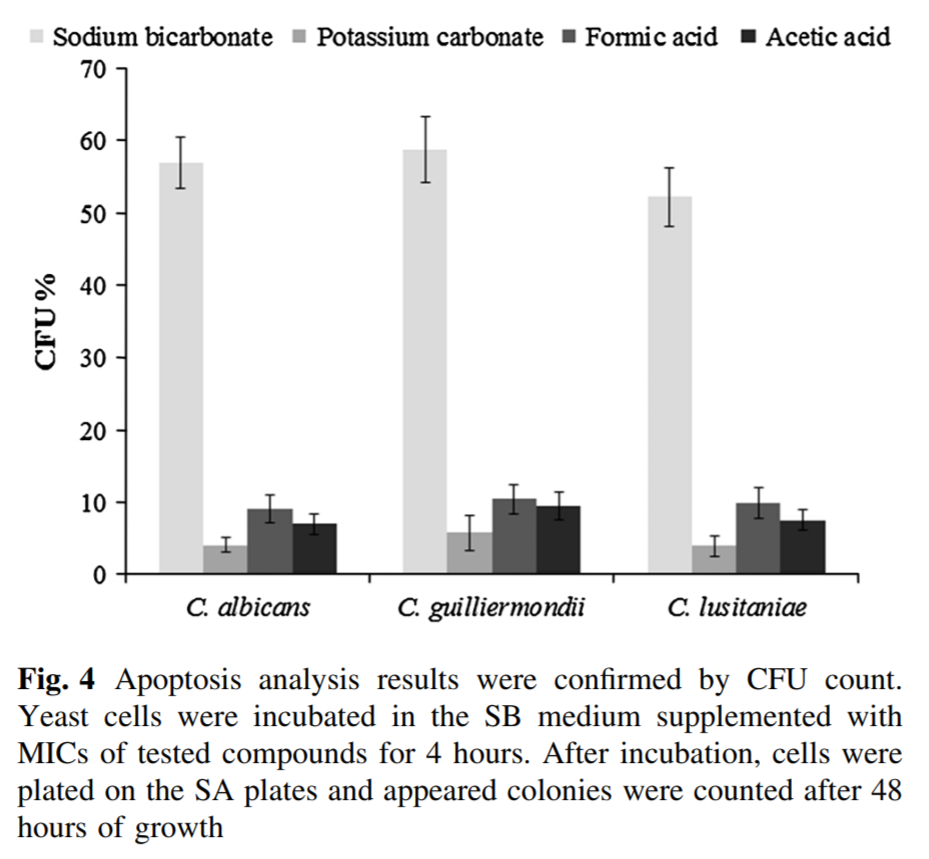
Sodium Bicarbonate, Candida Biofilm, and Yeast Adhesion Ability
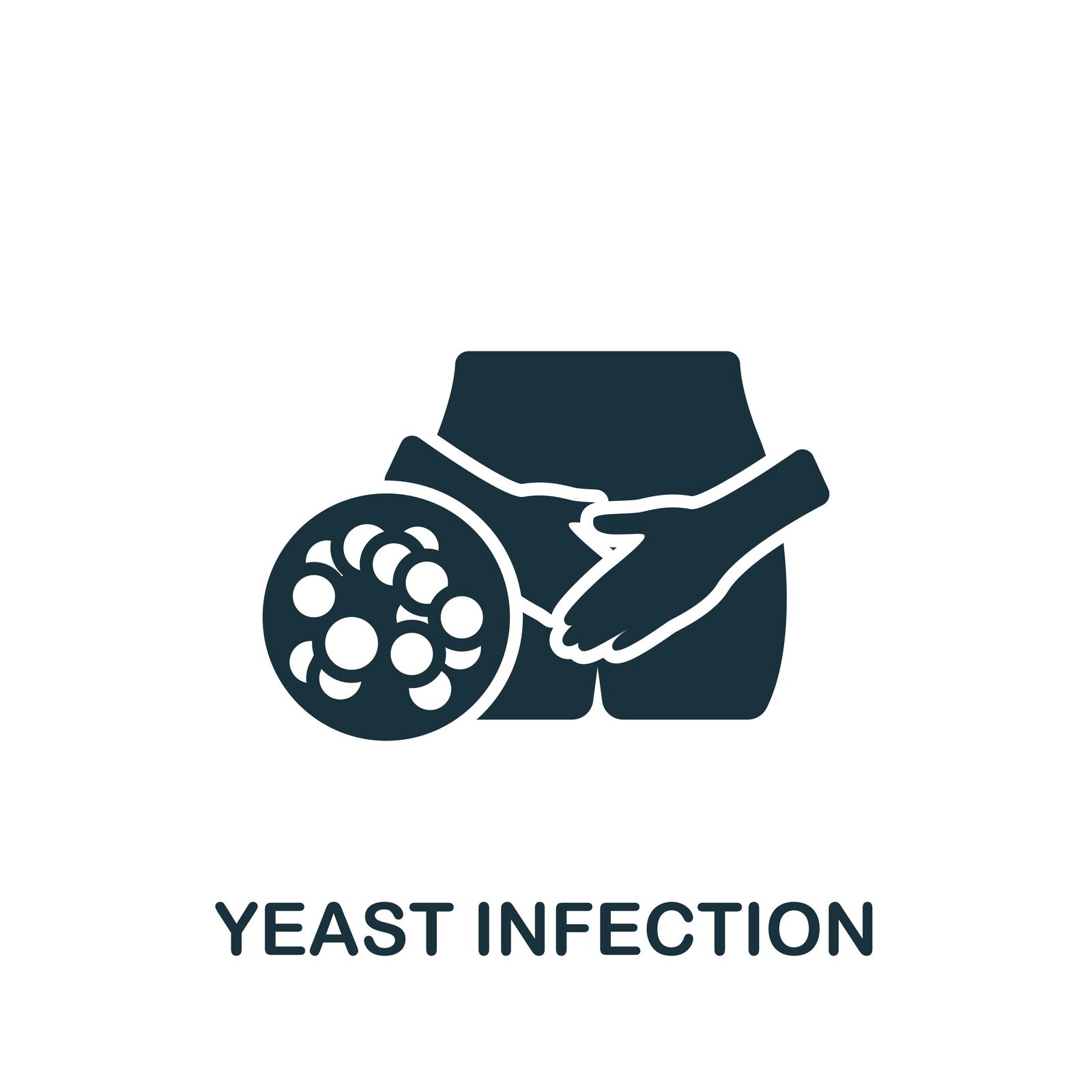
An additional study, published in the Journal of Applied Microbiology [105.4 (2008): 986-992], looked at how well baking soda would stop the development of Candida biofilm. The study found that baking soda seemed to do little to halt Candida albicans from creating biofilm. Thus, baking soda is a nearly useless home remedy for getting rid of yeast biofilm. Don’t expect an entrenched vaginal yeast infection’s biofilm to be eradicated by using baking soda.
Another study, sought to see how efficacious baking soda would be at stopping Candida albicans from adhering to a surface. This important research was published in the journal Brazilian Oral Research [23.4 (2009): 381-385]. The study used 50 different four mm2 plates to test this yeast’s ability to latch on and grip the surface. After the Candida was allowed to grow on the plates, some of them were washed with a five percent sodium bicarbonate solution.
Also tested in this study, was white vinegar—some of the plates were washed only with white vinegar as well. In all, there were five different chemicals evaluated: sodium bicarbonate (labeled as “group B”), white vinegar (labeled as “group V”), Corega Tabs (labeled as “group C”), digluconate chlorhexidine (labeled as “group P”), and a control fluid: distilled water. The study found that only group B and P demonstrated a significant reduction in Candida albican’s ability to adhere to the plates.
Eliminate Bacterial Vaginosis & Vaginal Odor
Jennifer O’Brien is one prominent expert on BV that knows how to get rid of vaginal odor. BV is a common infection that you don’t have to put up with.
Jennifer will show you how to naturally eliminate vaginal odor in just 3 days.
A 60-day, 100% money back guarantee is provided.
Visit Official Site!Baking Soda Bath for Yeast Infection

A proper baking soda bath, for many ailments, should probably be done in a sitz bath style. The United States National Cancer Institute at the National Institutes of Health defines a sitz bath as follows: “A warm-water bath taken in a sitting position that covers only the hips and buttocks [source on Cancer.gov].” Another great piece of advice for taking a baking soda bath / sitz bath comes from the University of Iowa Women’s Health Center. According to their brief overview of vulvar skin care guidelines, the health center states the following regarding classic baking soda soaks:
Baking Soda soaks. Soak in lukewarm (not hot) bath water with 4-5 tablespoons of baking soda to help soothe vulvar itching and burning. Soak 1 to 3 times a day for 10 minutes. If you are using a sitz bath, use 1 to 2 teaspoons of baking soda.
Source article from the University of Iowa Women’s Health Center
It may not be the best idea to try and kill off the yeast with a baking soda bath; as this will likely require having at least a 10% concentration of baking soda in your bath water. As mentioned, a 5% baking soda concentration in your bath should effectively arrest the yeast’s growth. But, it’s going to be up to you how much baking soda you put in your bath. Sodium bicarbonate can absorb through the skin; and, vaginal interior to some degree. Consequently, make sure you talk to a medical doctor before you use gratuitous amounts of baking soda in a bath. And, certainly before using this household product with an infant or small child; as this may cause a health problem.
Case in point, one study relates the story of an infant whose mother used too much baking soda on her child’s diaper rash. The study was published in the scientific journal Pediatrics [67.6 (1981): 820-822]. The mother apparently put a large amount of sodium bicarbonate powder on her 4 month old infant—in an attempt to clear up diaper rash. The infant developed an acid-base disturbance; which, fortunately, was resolved after the baking soda treatment was ceased. So, make sure you do not subject small children to extreme amounts of baking soda. If you want to use a concentration of baking soda that can stop yeast growth—or more—make sure you get the approval of a medical professional before you do anything like this.
In addition to baking soda, try adding in a few essential oils to a sitz bath—such as tea tree oil and thyme oil. Essential oils should help to perfume the bath to some extent; and, provide an extra degree of antifungal ability to the shallow bath water. You can also use anti-yeast herbs, like chamomile, in your bath as well! For more information making a tea tree oil bath; or more on using chamomile for a yeast infection bath; you can check out these pages:
- How to use tea tree oil for treating a yeast infection
- Using chamomile for treating a Candida problem
Clair Goodall: Author & Nature Lover
Clair Goodall is a bee-obsessed natural medicine convert from Minnesota. She is one expert you might want to know more about!
Clair will help you protect you and your family from toxic products and chemicals and help you discover solutions from nature.
Also, Clair’s book is backed by a 60-day, 100% money back guarantee
Visit Official Site!Side Effects of Too Much Baking Soda

The next scientific exposition, on the topic of baking soda overdoses, we will investigate was published in the Journal of Clinical Pharmacy and Therapeutics [39.1 (2014): 73-77]. The study looked at people who improperly used, or ingested, baking soda that ended up being reported to the California Poison Control System between the years 2000 and 2012. The study also states the common fact, that sodium bicarbonate, has very real capability of causing severe toxicity when you swallow extreme amounts. The label from Arm & Hammer baking soda (a very popular brand in the States) operationalizes how to properly use this useful substance when you want swallow a bit of it (say when you want to calm your acidic stomach that is giving you heartburn). However, many people seem to go overboard with baking soda; and, there are some real dangers that can occur when you get too much in you. One common group of people who overdosed on baking soda, cited by the study, were those who wanted to fool a urine drug test. Another group of people cited by this research, who overdose occasionally on this household product, are individuals who chronically use antacids.
The caution on using baking soda may seem a bit superfluous; however, the study reported that, of 192 accepted incidents of sodium bicarbonate poisoning (some of these incidents may have been misuse—not including ingestion), 20 people used a half-box; and, 9 people used more than one 8 ounce box of baking soda. So, you can see, some people get out of control in their radical use of this product. One person, examined by this study, consumed an entire box of baking soda to pass a drug test. Another individual ingested more than one whole box to help neutralize their stomach acid. Finally, another individual ate a quarter of a box to induce vomiting. Thus, not everyone stays within the guidelines put forth by Arm & Hammer’s baking soda label!
The following quotation, was taken from the study’s conclusion, and outlines the general thoughts of the study. A very common symptom of too much sodium bicarbonate in the body is alkalosis. Alkalosis is an extreme alkaline state of body tissues or fluids; often this can cause cramps, nausea, unusual muscle movements, general weakness, and loss of the ability to have physical sensations.
Baking soda if misused in excessive amounts can result in serious acid/base and electrolyte imbalance requiring medical treatment. Patients often exceed the doses recommended on the product label, but adverse side effects were also noted when the recommended doses were administered. Those at highest risk include those who chronically self-administered an antacid or those who use a method to ‘beat’ a urine drug test. Other patient populations that should avoid use of baking soda include young children, pregnant women, alcoholics and those who are on diuretics.
Journal of Clinical Pharmacy and Therapeutics [39.1 (2014): 73-77]
Conclusions about this Home Remedy

Baking soda does not seem to have any Candida killing power at low concentrations; rather, it adequately inhibits (stops the growth) yeast cell proliferation at concentrations of around 5%. By halting further cell reproduction, your immune system can have an easier time clearing this invader from your body. Using a stronger concentration, a minimum of 20g baking soda / 200mL solvent (which would be like a 10% baking soda solution—the solvent could be water for instance), should kill Candida. Also, sodium bicarbonate did dislodge attached yeast from acrylic resin plates; so, it is likely it will also be able to detach yeast from the skin and mucosal linings (such as the inside of the mouth or vagina).
Consequently, baking soda is an acceptable home remedy for yeast infections. But, the key thing to remember is, not to go overboard. Too much exposure to baking soda can cause significant health problems; such as alkalosis. Ingesting baking soda is likely not going to help stop Candida in any way; and, it should only be considered a topical treatment—and never used on small children. Make sure you stick to the directions (as the orange photo of the label shows one example of such guidelines) when you use this product.
Linda Allen’s Fast, Safe, Natural Candida Cure (Gone in Just 12 Hours!)

One woman, Linda Allen, struggled frequently with yeast infections. Her problems seemed to all start in her late teen years; about the same time she developed a sinus infection. To solve this problem, Linda made an appointment with a doctor and quickly got a prescription. The doctor’s solution did work amazingly at first. Yet, a while later, Linda came down with another yeast infection. Yet again, Linda made an expensive appointment with her doctor. The physician gave her another prescription; and, like before it cleared her up her infection with ease. But, as you may have guessed, Linda came down with yet another yeast infection about a month later.
This cycle of Candida problems went on for a while in Linda’s life. In all, Linda suffered with Candida health problems (as many women and men unfortunately do) for close to 12 whole years! Those who knew Linda wondered if she was sicker than she was letting on, or was she just a hypochondriac? This poor woman’s money was also being exhausted with all the medical bills she was paying. Linda found herself living in a cramped apartment and feeling physically miserable. Thankfully, Linda’s life changed for the best when she finally made an appointment with a naturopathic practitioner (a naturopath is an individual who focuses on natural medicines for the healing physical ailments).
The naturopath quickly pointed out that Linda was suffering from a systemic Candida infection. This was causing her outrageous health problems. Linda now knew, that if she could fully eliminate this yeast from her body, she would be back to her healthy, happy self. And, so began nearly a decade long quest to understand Candida and how to effectively cure herself. Linda tried a vast array of alternative treatments and spent a small fortune in the process. In addition, Linda consumed medical texts that could offer her some insight into properly addressing her situation. When she could, Linda spoke with medical experts about Candida and gleaned important information from these talks. It took a while, but finally Linda did develop a radical approach to getting rid of Candida—permanently. She then spent a year refining her therapy before giving it a try on herself. When she did, Linda found that her health began to dramatically improve. She wasn’t getting yeast infections anymore; and, for the first time in a long time, she was feeling wonderful. Eventually, after a long time of enjoying her newfound vitality, Linda decided she had done it! She had permanently ended the misery Candida had been causing in her life. She was healthy again.
After her breakthrough, Linda went on to publish a book that describes exactly how to replicate her success and fully recover from systemic Candida health issues. Also, she explains exactly how to get rid of a regular yeast infection in just 12 hours time—guaranteed. Since writing her book in 2004, over 100,000 people from around the world have used Linda’s book to permanently end their yeast related health problems. Using Linda’s approach, you won’t ever have to spend a small fortune routinely buying over the counter or prescription yeast infection treatments. And, Linda shows you how to do it with safe, natural ingredients that are no sweat to find—plus much more.
Linda’s book is published by a large online publisher owned by the prominent U.S. based company Keynetics Incorporated. Her publisher handles all her orders and you can even use PayPal on your order if you wish. Linda guarantees you’ll be free of localized yeast infection in just 12 hours time or your money back. You will have a full 60 days to get your money back if you don’t get rid of your systemic Candida problem in a few weeks or your yeast infection in just 12 hours time. Linda’s publisher makes the process of getting your money back safe and very easy. If you would like to learn more about Linda’s personal journey to better health, or see some of the many testimonials from those who gave her program a try, you can find out much more at Linda Allen’s website!
Author: Mr. Nicholas Gross

Nick Gross is a natural medicine enthusiast who has been researching and writing about natural medicine since 2008. Nick is primarily a web developer but also researches and authors written and video content about natural health. Nick has a bachelor’s degree in Management Information Systems from the University of Northern Iowa.
Disclaimer
The information on this website is not a prescription for anyone. This information is for informational or educational purposes only, and is not a substitute for professional medical advice or consultations with healthcare professionals.
Affiliate Disclosure
Some of the links provided on this website are affiliate links. When a purchase is made through these links, Candida Hub earns money from commission. This helps to keep the website up and helpful to people for free. Thank you for any support!
Stay Up to Date
If you enjoyed this article, consider following / liking our Facebook page. This page is primarily utilized to alert followers of new articles that are put on Candida Hub. Candida related news is also discussed. While you are there, you can see what has been more recently added to Candida Hub.
SOURCES:
- https://books.google.com/books?id=V4p77KU8BE0C — Saltmarsh, Mike. “Essential Guide to Food Additives.” Royal Society of Chemistry, 2013. ISBN: 9781849735605
- Arm & Hammer Baking Soda — Section of the brand’s website dealing with their popular baking soda.
- http://dx.doi.org/10.4103/1658-631X.149668 — Ali, Aiman A., and Fahad A. Al Harbi. "The minimum inhibitory concentration of different candidal disinfecting agents." Saudi Journal of Medicine and Medical Sciences 3.1 (2015): 26. PDF Full Text
- http://dx.doi.org/10.1007/s11046-012-9583-2 — Letscher-Bru, V., C. Obszynski, M. Samsoen, M. Sabou, J. Waller, and E. Candolfi. "Antifungal Activity of Sodium Bicarbonate Against Fungal Agents Causing Superficial Infections." Mycopathologia 175.1 (2013): 153-158. PubMed
- http://dx.doi.org/10.1007/s00284-014-0585-9 — Lastauskiene, Egle, et al. "Formic acid and acetic acid induce a programmed cell death in pathogenic Candida species." Current microbiology 69.3 (2014): 303-310. PubMed
- http://dx.doi.org/10.1111/j.1365-2672.2008.03823.x —Gawande, P. V., et al. "Antibiofilm activity of sodium bicarbonate, sodium metaperiodate and SDS combination against dental unit waterline associated bacteria and yeast." Journal of applied microbiology 105.4 (2008): 986-992. PubMed, Full Text PDF
- http://dx.doi.org/10.1590/S1806-83242009000400006 — Sousa, Fernando Augusto Cervantes Garcia de, et al. "Effect of sodium bicarbonate on Candida albicans adherence to thermally activated acrylic resin." Brazilian oral research 23.4 (2009): 381-385. PubMed, Full Text PDF
- http://www.ncbi.nlm.nih.gov/pubmed/7232046 — Gonzalez, Jose, and Ronald J. Hogg. "Metabolic alkalosis secondary to baking soda treatment of a diaper rash." Pediatrics 67.6 (1981): 820-822.
- http://dx.doi.org/10.1111/jcpt.12113 — Al-Abri, S. A., and T. Kearney. "Baking soda misuse as a home remedy: case experience of the California Poison Control System." Journal of clinical pharmacy and therapeutics 39.1 (2014): 73-77. PubMed, Full Text PDF





